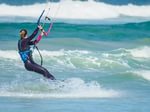Hawaiian watersports legends Robby Naish, Pete Cabrinha, and Don Montague share their personal stories in an audiobook that is filled with good music and laid back vibes.
Through unreleased interview recordings, taken from the award-winning film “Chapter One – The Kiteboard Legacy Begins,” the three men speak about the evolution of watersports in Hawaii, and the birth of a new sport – kitesurfing.
In the early 1990s, professional windsurfer and big wave record holder Pete Cabrinha is part of a group of creative individuals in Maui called “The Strapped Crew,” which also included Laird Hamilton and Dave Kalama.
“Laird was one of the first to try kitesurfing in Maui, doing what we call ‘downwinders.’ At first, I wasn’t really interested,” explains Cabrinha.
“It wasn’t until Flash Austin arrived on the island and I saw him jump off a wave. He stayed in the air longer than I have ever seen any windsurfer stay in the air, and it was exactly at that moment I wanted to give this thing a go.”
Dave Kalama also remembers those exciting times.
“When that first shipment of Wipika kites arrived on the island, it was off to the races who could hurt themselves, break something, but have fun along the way,” adds Kalama.
Kitesurfing: Too Dangerous For 99,9 Percent of the Population
Windsurfing legend Robby Naish started developing new products, but with kitesurfing equipment still in its infancy, the sport was so dangerous he didn’t even want people to try it.
“The first advertisement that we did in 1999 was: Kitesurfing, absolutely, positively the wrong sport for 99,9 percent of the world’s population.”
Deadly casualties put the sport in a bad light but Don Montague, an athlete and sail designer at Naish Sails, was determined to make this sport accessible to the public.
“Everybody was against me when I started developing kitesurf gear. Until one day I was able to kitesurf at the famous windsurf spot Hookipa, and not go downwind. That was the day it all changed,” recalls Montague.
Two decades of engineering later, Don Montague still continues his mission to improve the performance of kites and experiments with putting kites on boats.

“I discussed my project with Larry Page and Sergey Brin from Google, and they said: ‘instead of sailing around the world with your kiteboat, why don’t you try to save the planet?’ A conversation that resulted in them founding Makani, a company that produces green energy with kites,” reveals the kitesurfing pioneer.
In this audiobook, the stories of Robby, Pete and Don document a piece of history in the world of watersports in Hawaii. It also aims to inspire its listeners with a unique view of life.
“After making the movie ‘Chapter One – The Kiteboard Legacy Begins,’ I felt many good stories had not made it to the cut. I always found it very relaxing to listen to these Hawaiian stories, but instead of using the recordings to make another film, I thought it would be nice to create an audiobook and let imagination do the work,” concludes Bob van de Gronde, the film’s director.
About the Authors
Robby Naish
Robby Naish is a legendary figure in the sport of windsurfing and kiteboarding.
Robby’s family moved to Hawaii when he was five years old and his father Rick, who had a deep connection with the ocean, passed that on to Robby in his formative years, getting him into the waves at any opportunity.
While he was still competing, Robby worked on building the Naish brand and produced “RIP,” one of the most highly acclaimed windsurfing films of all time. Now in his 50s, he still shreds harder than most riders half his age whether he’s kiting, SUPing, surfing or windsurfing.
Pete Cabrinha
Pete Cabrinha played a crucial role in developing surfing, windsurfing, and kitesurfing, rode a record-breaking 70-foot wave, founded his own sports brand and is a respected fine artist.
Pete Cabrinha puts his success down to “luck, timing and a passion for doing things differently” but he’s being modest – you don’t achieve what he has without that killer combination of drive and talent.
Don Montague
He was the head of Research & Development at Naish when kiteboarding first started to emerge.
Ever the innovator, Don was instrumental in helping design some of the first ever production kites and is perhaps one of the unsung heroes of the sport of kiteboarding.
His fascination with kites led him to design wind-powered outrigger canoes and develop the idea of ‘kite boating’ before, in 2006, he started his own company, Makani Power, with the aim of using wind power to generate electricity.
Google acquired Makani Power in 2013, and his key focus is on his KiteBoat Project which involves using large kites to power catamarans across the water at record sailing speed.





Recent Comments